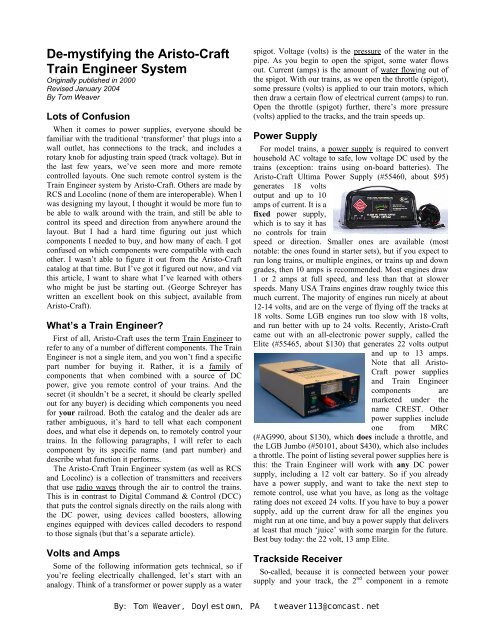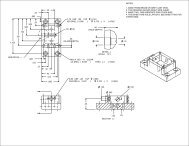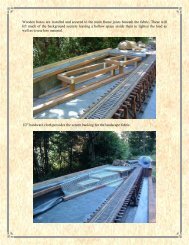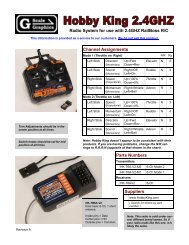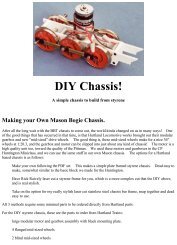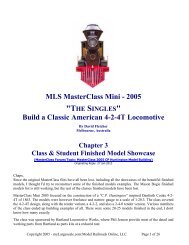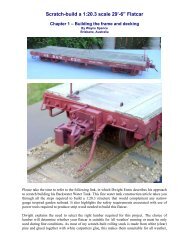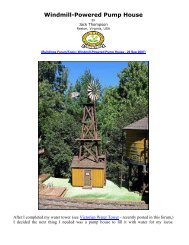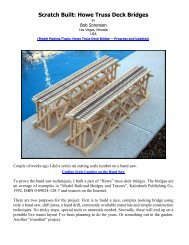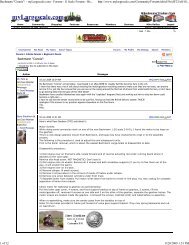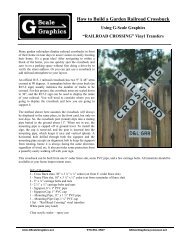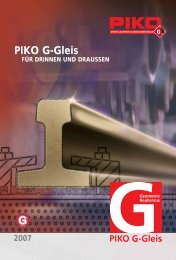De-mystifying the Aristo-Craft Train Engineer System
De-mystifying the Aristo-Craft Train Engineer System
De-mystifying the Aristo-Craft Train Engineer System
Create successful ePaper yourself
Turn your PDF publications into a flip-book with our unique Google optimized e-Paper software.
<strong>De</strong>-<strong>mystifying</strong> <strong>the</strong> <strong>Aristo</strong>-<strong>Craft</strong><br />
<strong>Train</strong> <strong>Engineer</strong> <strong>System</strong><br />
Originally published in 2000<br />
Revised January 2004<br />
By Tom Weaver<br />
Lots of Confusion<br />
When it comes to power supplies, everyone should be<br />
familiar with <strong>the</strong> traditional ‘transformer’ that plugs into a<br />
wall outlet, has connections to <strong>the</strong> track, and includes a<br />
rotary knob for adjusting train speed (track voltage). But in<br />
<strong>the</strong> last few years, we’ve seen more and more remote<br />
controlled layouts. One such remote control system is <strong>the</strong><br />
<strong>Train</strong> <strong>Engineer</strong> system by <strong>Aristo</strong>-<strong>Craft</strong>. O<strong>the</strong>rs are made by<br />
RCS and Locolinc (none of <strong>the</strong>m are interoperable). When I<br />
was designing my layout, I thought it would be more fun to<br />
be able to walk around with <strong>the</strong> train, and still be able to<br />
control its speed and direction from anywhere around <strong>the</strong><br />
layout. But I had a hard time figuring out just which<br />
components I needed to buy, and how many of each. I got<br />
confused on which components were compatible with each<br />
o<strong>the</strong>r. I wasn’t able to figure it out from <strong>the</strong> <strong>Aristo</strong>-<strong>Craft</strong><br />
catalog at that time. But I’ve got it figured out now, and via<br />
this article, I want to share what I’ve learned with o<strong>the</strong>rs<br />
who might be just be starting out. (George Schreyer has<br />
written an excellent book on this subject, available from<br />
<strong>Aristo</strong>-<strong>Craft</strong>).<br />
What’s a <strong>Train</strong> <strong>Engineer</strong>?<br />
First of all, <strong>Aristo</strong>-<strong>Craft</strong> uses <strong>the</strong> term <strong>Train</strong> <strong>Engineer</strong> to<br />
refer to any of a number of different components. The <strong>Train</strong><br />
<strong>Engineer</strong> is not a single item, and you won’t find a specific<br />
part number for buying it. Ra<strong>the</strong>r, it is a family of<br />
components that when combined with a source of DC<br />
power, give you remote control of your trains. And <strong>the</strong><br />
secret (it shouldn’t be a secret, it should be clearly spelled<br />
out for any buyer) is deciding which components you need<br />
for your railroad. Both <strong>the</strong> catalog and <strong>the</strong> dealer ads are<br />
ra<strong>the</strong>r ambiguous, it’s hard to tell what each component<br />
does, and what else it depends on, to remotely control your<br />
trains. In <strong>the</strong> following paragraphs, I will refer to each<br />
component by its specific name (and part number) and<br />
describe what function it performs.<br />
The <strong>Aristo</strong>-<strong>Craft</strong> <strong>Train</strong> <strong>Engineer</strong> system (as well as RCS<br />
and Locolinc) is a collection of transmitters and receivers<br />
that use radio waves through <strong>the</strong> air to control <strong>the</strong> trains.<br />
This is in contrast to Digital Command & Control (DCC)<br />
that puts <strong>the</strong> control signals directly on <strong>the</strong> rails along with<br />
<strong>the</strong> DC power, using devices called boosters, allowing<br />
engines equipped with devices called decoders to respond<br />
to those signals (but that’s a separate article).<br />
Volts and Amps<br />
Some of <strong>the</strong> following information gets technical, so if<br />
you’re feeling electrically challenged, let’s start with an<br />
analogy. Think of a transformer or power supply as a water<br />
spigot. Voltage (volts) is <strong>the</strong> pressure of <strong>the</strong> water in <strong>the</strong><br />
pipe. As you begin to open <strong>the</strong> spigot, some water flows<br />
out. Current (amps) is <strong>the</strong> amount of water flowing out of<br />
<strong>the</strong> spigot. With our trains, as we open <strong>the</strong> throttle (spigot),<br />
some pressure (volts) is applied to our train motors, which<br />
<strong>the</strong>n draw a certain flow of electrical current (amps) to run.<br />
Open <strong>the</strong> throttle (spigot) fur<strong>the</strong>r, <strong>the</strong>re’s more pressure<br />
(volts) applied to <strong>the</strong> tracks, and <strong>the</strong> train speeds up.<br />
Power Supply<br />
For model trains, a power supply is required to convert<br />
household AC voltage to safe, low voltage DC used by <strong>the</strong><br />
trains (exception: trains using on-board batteries). The<br />
<strong>Aristo</strong>-<strong>Craft</strong> Ultima Power Supply (#55460, about $95)<br />
generates 18 volts<br />
output and up to 10<br />
amps of current. It is a<br />
fixed power supply,<br />
which is to say it has<br />
no controls for train<br />
speed or direction. Smaller ones are available (most<br />
notable: <strong>the</strong> ones found in starter sets), but if you expect to<br />
run long trains, or multiple engines, or trains up and down<br />
grades, <strong>the</strong>n 10 amps is recommended. Most engines draw<br />
1 or 2 amps at full speed, and less than that at slower<br />
speeds. Many USA <strong>Train</strong>s engines draw roughly twice this<br />
much current. The majority of engines run nicely at about<br />
12-14 volts, and are on <strong>the</strong> verge of flying off <strong>the</strong> tracks at<br />
18 volts. Some LGB engines run too slow with 18 volts,<br />
and run better with up to 24 volts. Recently, <strong>Aristo</strong>-<strong>Craft</strong><br />
came out with an all-electronic power supply, called <strong>the</strong><br />
Elite (#55465, about $130) that generates 22 volts output<br />
and up to 13 amps.<br />
Note that all <strong>Aristo</strong>-<br />
<strong>Craft</strong> power supplies<br />
and <strong>Train</strong> <strong>Engineer</strong><br />
components are<br />
marketed under <strong>the</strong><br />
name CREST. O<strong>the</strong>r<br />
power supplies include<br />
one from MRC<br />
(#AG990, about $130), which does include a throttle, and<br />
<strong>the</strong> LGB Jumbo (#50101, about $430), which also includes<br />
a throttle. The point of listing several power supplies here is<br />
this: <strong>the</strong> <strong>Train</strong> <strong>Engineer</strong> will work with any DC power<br />
supply, including a 12 volt car battery. So if you already<br />
have a power supply, and want to take <strong>the</strong> next step to<br />
remote control, use what you have, as long as <strong>the</strong> voltage<br />
rating does not exceed 24 volts. If you have to buy a power<br />
supply, add up <strong>the</strong> current draw for all <strong>the</strong> engines you<br />
might run at one time, and buy a power supply that delivers<br />
at least that much ‘juice’ with some margin for <strong>the</strong> future.<br />
Best buy today: <strong>the</strong> 22 volt, 13 amp Elite.<br />
Trackside Receiver<br />
So-called, because it is connected between your power<br />
supply and your track, <strong>the</strong> 2 nd component in a remote<br />
By: Tom Weaver, Doylestown, PA tweaver113@comcast.net
controlled layout is a trackside receiver (#55471, about<br />
$80). It increases or decreases <strong>the</strong> voltage to <strong>the</strong> track<br />
according to a 27Mhz radio signal it receives on its antenna.<br />
It does <strong>the</strong> job of a throttle, controlling <strong>the</strong> speed of <strong>the</strong><br />
train, but without a rotary knob. The advantage of this<br />
component, besides <strong>the</strong> fact that you can control <strong>the</strong> trains<br />
from anywhere on <strong>the</strong> layout, is that <strong>the</strong>re are NO<br />
modifications required to <strong>the</strong> engines.<br />
Any engine from any manufacturer<br />
can be controlled with this device<br />
without having to add electronics<br />
inside <strong>the</strong> engine. Usually, <strong>the</strong> power<br />
supply and <strong>the</strong> receiver are installed<br />
in <strong>the</strong> house or garage, and a heavy<br />
pair of wires carries <strong>the</strong> DC current to <strong>the</strong> tracks. It works<br />
best if <strong>the</strong> antenna is oriented vertically, and mounted up<br />
high.<br />
Transmitter<br />
The 3 rd component in a remote control system is <strong>the</strong> hand<br />
held transmitter (#55473, about $65). About <strong>the</strong> size of a<br />
TV remote control (those<br />
work on infrared, not radio<br />
waves), it has a button to<br />
speed up <strong>the</strong> train, ano<strong>the</strong>r<br />
to slow down <strong>the</strong> train, and<br />
a pair of buttons to change<br />
direction. There’s also an<br />
emergency stop button,<br />
which instantly turns <strong>the</strong><br />
track voltage down to zero,<br />
very handy if <strong>the</strong>re’s a derailment. The transmitter sends<br />
out a 27Mhz radio signal (only when you push a button),<br />
which in ideal conditions can be picked up by <strong>the</strong> receiver<br />
at ranges up to 100 feet or more, though in some<br />
installations, it might be less than that. I’ve found, much to<br />
my delight, that <strong>the</strong> radio signals pass through <strong>the</strong> concrete<br />
wall of my house and control <strong>the</strong> receivers in <strong>the</strong> basement,<br />
even at ranges beyond 100 feet. The transmitter can be<br />
purchased by itself, or paired with a receiver (#55470,<br />
about $120). The transmitter is a universal device, meaning<br />
that it can control as many receivers as you eventually add<br />
to your railroad (maximum of 100). So, using <strong>the</strong> same<br />
transmitter, you could control two or three or more<br />
receivers (train loops). This is done by selecting a different<br />
frequency and a different channel on <strong>the</strong> transmitter (There<br />
are ten frequencies, and for each frequency <strong>the</strong>re are ten<br />
unique channels). These selections are made on <strong>the</strong><br />
transmitter using some of <strong>the</strong> buttons and <strong>the</strong> LED display<br />
at <strong>the</strong> top. More on this subject later in <strong>the</strong> article.<br />
On-board receivers<br />
This is where things might start to get confusing. <strong>Aristo</strong>-<br />
<strong>Craft</strong> makes ano<strong>the</strong>r radio receiver, called <strong>the</strong> mini onboard<br />
receiver (#55490, was about $80). This is meant to be<br />
installed within <strong>the</strong> train itself (<strong>the</strong> engine, or a trailing car).<br />
Most people use <strong>the</strong>se in conjunction with on-board<br />
batteries. The miniature receiver is wired between <strong>the</strong><br />
battery pack and <strong>the</strong> motors, and controls <strong>the</strong> speed of <strong>the</strong><br />
train based on radio signals. The same #55473 transmitter<br />
described above can be used with this mini receiver,<br />
because <strong>the</strong>y both operate in <strong>the</strong> same 27Mhz frequency<br />
band. So now, instead of getting its current from <strong>the</strong> track,<br />
<strong>the</strong> train gets its current from on-board batteries. This has<br />
several huge advantages: This makes it easier to run<br />
multiple trains on <strong>the</strong> same track, and control <strong>the</strong> speed of<br />
each independently, and also it also sidesteps <strong>the</strong><br />
requirement to constantly clean <strong>the</strong> tops of <strong>the</strong> rails as is<br />
often <strong>the</strong> case with track powered layouts. The big<br />
disadvantage is you must open up <strong>the</strong> engine and install <strong>the</strong><br />
mini-receiver and its antenna. And if you have a lot of<br />
engines, that can get expensive. Some people put <strong>the</strong><br />
batteries and <strong>the</strong> mini receiver in a trailing car, and run<br />
wires to <strong>the</strong> engine. That helps to keep <strong>the</strong> costs down,<br />
since you can use <strong>the</strong> same trailing car with a different<br />
engine each time you run, but you’re always lugging around<br />
<strong>the</strong> same trailing car right behind <strong>the</strong> engine all <strong>the</strong> time. I<br />
did mention that <strong>the</strong> antenna for this receiver is now inside<br />
<strong>the</strong> train, and close to <strong>the</strong> ground. Unfortunately, that has<br />
<strong>the</strong> adverse effect of reducing <strong>the</strong> maximum range by which<br />
<strong>the</strong> receiver and transmitter can communicate, in some<br />
cases, to as little as 10 feet. Having said that, <strong>the</strong> #55490 is<br />
now out of production.<br />
So in 2002, <strong>Aristo</strong>-<strong>Craft</strong> released a new mini on-board<br />
receiver (#55491, about $100) that operates in <strong>the</strong> higher<br />
75Mhz frequency band,<br />
which performs all <strong>the</strong><br />
same functions, but ideally<br />
offers better range<br />
performance than its<br />
predecessor. Oh, and now<br />
you have to use a new<br />
75Mhz transmitter with it<br />
(#55003, about $65) since<br />
27Mhz transmitters don’t work with 75Mhz receivers. It’s<br />
easy to tell <strong>the</strong>m apart: 27Mhz transmitters are housed in a<br />
black case, and 75 Mhz transmitters are housed in a gray<br />
case, but <strong>the</strong> buttons and <strong>the</strong> functions are <strong>the</strong> same. 75Mhz<br />
stuff can be bought as a pair (#55492, about $160). One<br />
more thing: <strong>Aristo</strong>-<strong>Craft</strong> engines produced since 2002 have<br />
a receptacle inside so that this mini receiver can be plugged<br />
in, which eliminates <strong>the</strong> need to cut and solder a bunch of<br />
wires. The way <strong>the</strong>y can be identified is by <strong>the</strong> small plug<br />
found near <strong>the</strong> coupler at each end of <strong>the</strong> locomotive, where<br />
a trailing car can optionally be connected.<br />
There’s more. The 27Mhz mini receiver and <strong>the</strong> 75Mhz<br />
mini receiver are each rated at 3 amps. Sometimes <strong>the</strong>re’s<br />
an engine (or a multi-unit lashup) that draws more than 3<br />
amps. You can (and its been successfully done) take <strong>the</strong><br />
trackside receiver, which is rated at 10 amps, out of its case,<br />
and mount <strong>the</strong> circuit board and its antenna inside <strong>the</strong><br />
engine or trailing car, and connect it to some suitably sized<br />
batteries.<br />
Here’s ano<strong>the</strong>r idea for those bigger layouts. You say you<br />
want multi train action, but batteries aren’t for you? Then<br />
By: Tom Weaver, Doylestown, PA tweaver113@comcast.net
hook <strong>the</strong> Elite power supply directly to <strong>the</strong> rails (with fuses)<br />
and put a mini on-board receiver in every engine. Just don’t<br />
put a stock engine on <strong>the</strong> rails, because at 22 volts it will<br />
take off like a slot car! (<strong>De</strong>scribed in Figure 4)<br />
Last but not least, some of us have a considerable<br />
investment in 27Mhz equipment already, and don’t want<br />
<strong>the</strong> hassles of intermixing 75Mhz and 27Mhz equipment.<br />
Since <strong>the</strong> #55490 is out of production, <strong>the</strong> #55491 can be<br />
retrofitted with a part that allows it to operate in <strong>the</strong> 27Mhz<br />
band. This is just an RF chip that attaches to <strong>the</strong> mini<br />
receiver (#55489, about $25).<br />
Accessory Receivers<br />
If I didn’t lose you yet, <strong>the</strong>re are two additional receivers<br />
in <strong>the</strong> TE family. The accessory receiver (#55474, about<br />
$45) with its antenna is usually installed inside an engine to<br />
turn on or off various things like lights, a bell or a horn. The<br />
switch receiver (#55475, about $40) with its antenna, is<br />
usually installed in <strong>the</strong> layout where electrically controlled<br />
turnouts are employed, so that as many as 5 of those<br />
turnouts can be operated remotely. The same universal<br />
transmitter described earlier can operate both of <strong>the</strong>se<br />
components, using <strong>the</strong> A through F buttons toward <strong>the</strong><br />
bottom of <strong>the</strong> transmitter.<br />
How to Choose<br />
Phew, still seems confusing, how does a person decide<br />
what to buy? If you like <strong>the</strong> idea of not modifying engines,<br />
and you have a method for keeping <strong>the</strong> track clean (Scotch<br />
Brite pad, track cleaning car, Rail Zip, Goof Off, stainless<br />
steel track, but that’s outside <strong>the</strong> scope of this article), <strong>the</strong>n<br />
track power is for you. A power supply (assuming you<br />
don’t have one), a trackside receiver and a 27Mhz<br />
transmitter would cost about $240 street price. You could<br />
<strong>the</strong>n operate one train or multiple trains (up to ten amps<br />
total), but <strong>the</strong>y would all move in <strong>the</strong> same direction at<br />
roughly <strong>the</strong> same speed (depending on manufacturer).<br />
Track power has definite advantages for large layouts<br />
running multi-engine long trains, which could exceed <strong>the</strong><br />
capacity of on-board batteries available today. But it does<br />
require investing in a power supply, some heavy gage wire<br />
(and probably a few rail clamps), and <strong>the</strong> periodic chore of<br />
cleaning <strong>the</strong> track.<br />
If you like <strong>the</strong> idea of never cleaning track, never<br />
installing wires to <strong>the</strong> track, never worrying about track<br />
joiners, and don’t mind opening up each locomotive to<br />
install electronics, <strong>the</strong>n battery power is for you. The first<br />
mini receiver and 75Mhz transmitter would cost about $160<br />
plus batteries (also outside <strong>the</strong> scope of this article). Each<br />
additional install would cost $100 plus batteries. Or, you<br />
could put <strong>the</strong> stuff in a trailing car, and use a plug to <strong>the</strong><br />
engine. By <strong>the</strong> time you retrofit your 3 rd engine, <strong>the</strong> outlay<br />
is higher than for track power, but <strong>the</strong> huge advantage is<br />
that each train is now independent, and can be slowed down<br />
or stopped even while <strong>the</strong> o<strong>the</strong>rs continue to run. You don’t<br />
have to buy ano<strong>the</strong>r transmitter each time you equip ano<strong>the</strong>r<br />
engine, because <strong>the</strong> transmitter is universal and can<br />
communicate with <strong>the</strong> entire line of receivers. Though<br />
technically <strong>the</strong> transmitter can control 100 receivers (10<br />
frequencies times 10 channels), you have to take your eyes<br />
off <strong>the</strong> trains and look at <strong>the</strong> LED display to make <strong>the</strong><br />
selection. From a practical viewpoint, I find controlling<br />
more than about 3 trains becomes tedious.<br />
If you’re going to run a combination of track power and<br />
battery power, you’ll start with 27Mhz equipment for <strong>the</strong><br />
track power, <strong>the</strong>n add ei<strong>the</strong>r 27Mhz on-board equipment (if<br />
you want to be able to use <strong>the</strong> same transmitters), or 75Mhz<br />
on-board equipment (if you don’t mind using several<br />
transmitters).<br />
Linking<br />
When you buy any receiver, you have to set its codes for<br />
<strong>the</strong> frequency and channel that it will respond to (just like a<br />
garage door opener). This setup is done just once, and from<br />
<strong>the</strong>n on, it will remember that specific frequency and<br />
channel, even after power is turned off. This is<br />
accomplished through a process called linking. First you<br />
select <strong>the</strong> frequency and channel on <strong>the</strong> transmitter. Then<br />
you press and hold buttons on <strong>the</strong> transmitter and <strong>the</strong><br />
receiver simultaneously to set that receiver’s codes. Hint:<br />
This is a good time to write <strong>the</strong>m down; after all, <strong>the</strong>re are<br />
100 choices. (Older style 27 Mhz transmitters supported<br />
just two channels instead of ten, and <strong>the</strong> frequency was<br />
fixed. While being much more<br />
limited, it did have <strong>the</strong><br />
advantage of being very easy<br />
to use for two train operation,<br />
because you did not have to<br />
take your eyes off <strong>the</strong> trains.<br />
You could feel <strong>the</strong> ch1/ch2<br />
switch with your thumb and<br />
make <strong>the</strong> selection more<br />
quickly.)<br />
Multiple Operators<br />
If your railroad has grown to <strong>the</strong> point where you are<br />
trying to operate more than about 3 trains at <strong>the</strong> same time,<br />
you’re a primary candidate for having more people and<br />
dividing up <strong>the</strong> workload. You will need to provide a<br />
separate transmitter to each operator at about $65 each.<br />
Each operator will be responsible for a subset of all <strong>the</strong><br />
trains. This approach is safer and a more fun way to run<br />
multiple trains. As long as separate frequencies (e.g., 75.1,<br />
75.2, 75.3, etc) are used, <strong>the</strong> transmitters will not interfere<br />
with each o<strong>the</strong>r, even if several operators push buttons at<br />
<strong>the</strong> same time.<br />
So far, we’ve established that for track power, <strong>the</strong>re is one<br />
receiver per track, and for battery power, <strong>the</strong>re is one<br />
receiver per engine, yet just one transmitter is all that is<br />
required to run one or more trains. You can operate a<br />
battery-powered train on a track-powered layout because<br />
<strong>the</strong>re’s switch in <strong>the</strong> engine that disconnects <strong>the</strong> wheel<br />
pickups when running on batteries. So, you could have a<br />
By: Tom Weaver, Doylestown, PA tweaver113@comcast.net
ig freight running on track power (and running and<br />
running, because <strong>the</strong>re’s no batteries to get depleted) while<br />
o<strong>the</strong>r trains, with on-board batteries, receiver and antenna<br />
scamper around on <strong>the</strong> same or different tracks.<br />
Multiple Independent Loops<br />
Many railroads grow to <strong>the</strong> point where <strong>the</strong>re are multiple<br />
loops of track. As long as <strong>the</strong>re are no electrical<br />
connections between <strong>the</strong> loops, <strong>the</strong>y can each be controlled<br />
by a separate trackside receiver, as explained in figure 2.<br />
And all <strong>the</strong> trackside receivers can be tied to a single power<br />
supply, as long as <strong>the</strong> combined currents of all <strong>the</strong> loops<br />
don’t exceed <strong>the</strong> rated amp capacity of <strong>the</strong> power supply.<br />
This allows a train on <strong>the</strong> 1 st loop to be controlled<br />
independently of a train on <strong>the</strong> 2 nd loop, etc. You can use<br />
one or more transmitters, whatever is more convenient.<br />
If <strong>the</strong> loops are connected via turnouts (and insulated rail<br />
joiners) and you expect that trains will traverse from one<br />
loop to <strong>the</strong> o<strong>the</strong>r, as explained in figure 3, <strong>the</strong>n it is<br />
imperative that each loop have a separate receiver and a<br />
separate power supply. Unless <strong>the</strong> receivers are tied to<br />
separate power supplies, <strong>the</strong>re will be severe damage to <strong>the</strong><br />
receivers and <strong>the</strong> engine wiring when an engine crosses<br />
between <strong>the</strong> loops.<br />
Miscellaneous<br />
So what are all those o<strong>the</strong>r components listed in <strong>the</strong> dealer<br />
ads? The Basic <strong>Train</strong> <strong>Engineer</strong> (#55480) is an entry level<br />
remote control system. It controls<br />
one train instead of several, has a 2<br />
amp capacity, and limited RF range.<br />
This is <strong>the</strong> kind of system you would<br />
use for a loop under <strong>the</strong> Christmas<br />
tree, but would be too limited for a<br />
garden railroad. Housed in an orange<br />
case. The control pack adaptor<br />
(#55401) is a manual throttle (with rotary knob) that installs<br />
between a power supply and <strong>the</strong> track in lieu of a trackside<br />
receiver. Although it too provides pulse width control (a<br />
feature that enhances slow speed running and lighting), it<br />
has no remote control capabilities.<br />
Oh, I didn’t tell you about pulse width control (PWC).<br />
Normal DC power, like that from a battery or most DC<br />
power sources, is often called linear. The TE receivers have<br />
a switch where you can select ei<strong>the</strong>r linear or PWC. In<br />
linear mode, <strong>the</strong> voltage output to <strong>the</strong> track starts at zero,<br />
and as you increase speed, <strong>the</strong> voltage goes up<br />
proportionally, till it reaches <strong>the</strong> maximum available from<br />
<strong>the</strong> power source. In PWC mode, <strong>the</strong> voltage to <strong>the</strong> tracks is<br />
rapidly switched between zero and <strong>the</strong> maximum available<br />
from <strong>the</strong> power source, like operating a light switch on-offon<br />
25,000 times a second. As you increase speed, you<br />
increase <strong>the</strong> % on time, and decrease <strong>the</strong> % off time.<br />
What’s <strong>the</strong> advantage? Engine motors often run more<br />
smoothly at slow speeds on PWC. And train lighting is<br />
brighter at slow speeds on PWC. What’s <strong>the</strong> downside?<br />
Sometimes circuit boards for sound systems don’t operate<br />
as expected. All of <strong>the</strong> <strong>Aristo</strong> TE receivers feature PWC.<br />
On <strong>the</strong> trackside receivers, it can be switched off (linear).<br />
Momentum and Time <strong>De</strong>lay<br />
The <strong>Train</strong> <strong>Engineer</strong> system includes two o<strong>the</strong>r features<br />
that most model railroaders find very desirable. One is<br />
Momentum, which determines how fast <strong>the</strong> speed increases<br />
as turn up <strong>the</strong> throttle. This simulates <strong>the</strong> weight of a heavy<br />
train as it tries to accelerate, thus avoiding a jackrabbit start.<br />
There are 5 choices for momentum, which is set during <strong>the</strong><br />
linking process. The o<strong>the</strong>r is Time <strong>De</strong>lay, which determines<br />
how long <strong>the</strong> train pauses when changing from forward to<br />
reverse. This simulates <strong>the</strong> various engineer actions needed<br />
to get <strong>the</strong> train moving in <strong>the</strong> opposite direction, and<br />
reduces wear and tear on <strong>the</strong> gears in <strong>the</strong> motor blocks.<br />
There are 5 choices for time delay, which is set during <strong>the</strong><br />
linking process.<br />
Conclusion<br />
<strong>Train</strong> <strong>Engineer</strong> component summary<br />
This article is intended to help model railroaders sort<br />
through <strong>the</strong> many components of <strong>the</strong> <strong>Aristo</strong>-<strong>Craft</strong> <strong>Train</strong><br />
<strong>Engineer</strong> system, and make smart purchasing decisions<br />
when preparing to build or expand a remote control train<br />
layout. It is not a how-to article, nor is it meant to replace<br />
<strong>the</strong> instructions that come with <strong>the</strong> equipment (which, I<br />
admit, are poorly written). The <strong>Aristo</strong>-<strong>Craft</strong> <strong>Train</strong> <strong>Engineer</strong><br />
system should meet <strong>the</strong> needs of <strong>the</strong> vast majority of model<br />
railroaders today at an affordable price. It is expandable by<br />
purchasing more components as <strong>the</strong> railroad or <strong>the</strong> number<br />
of operators grows. For more information, see George<br />
Schreyer’s book, or <strong>the</strong> web site at www.aristocraft.com.<br />
Component 27Mhz equipment 75Mhz equipment<br />
Transmitter #55473<br />
#55003<br />
Track power stuff<br />
10 frequencies times 10 channels (black) 10 frequencies times 10 channels (gray)<br />
Trackside Receiver<br />
#55471<br />
none<br />
(used with DC power supply,<br />
bought separately)<br />
10 amp capacity (with cooling fan)<br />
Cooling fan for above #55499 (above 5 amps) n/a<br />
#55473 / #55471 27Mhz set #55470 n/a<br />
By: Tom Weaver, Doylestown, PA tweaver113@comcast.net
On board battery power stuff<br />
Mini On-board Receiver<br />
(used with on-board batteries,<br />
bought separately)<br />
#55490<br />
2.5 amp capacity<br />
out of production<br />
#55491<br />
3 amp capacity<br />
Cooling fan for above #55498 #55498<br />
Mini receiver RF conversion #55489<br />
n/a<br />
board for #5491<br />
allows 55491 to work with #55473<br />
#55003 / #55491 75Mhz set n/a #55492<br />
Accessory receiver #55474 for 5 devices #55074 for 5 devices<br />
Switch receiver controller #55475 for 5 turnouts #55075 for 5 turnouts<br />
Acces. Receiver for #55491 n/a #55495 for sound and smoke<br />
Equipment list for various layouts<br />
Layout design Equipment list<br />
Figure 1: Single line, loop, or point-to-point<br />
Figure 2: Double line, two independent loops,<br />
NOT connected<br />
Figure 3: Double line, two connected loops<br />
Figure 4: Special case – DC power wired<br />
directly to track(s), any track plan, on-board<br />
receivers in every engine<br />
Track power:<br />
One power supply<br />
One (#55471) 27Mhz receiver<br />
One (#55473) 27Mhz transmitter<br />
Battery power:<br />
One battery pack per engine or trail car<br />
One (#55491) mini receiver per engine or trail car, with optional<br />
#55489 converter for 27Mhz<br />
One (#55473 or #55003) transmitter per operator<br />
Track power:<br />
One power supply<br />
One (#55471) 27Mhz receiver per track<br />
One (#55473) 27Mhz transmitter per operator<br />
Battery power:<br />
One battery pack per engine or trail car<br />
One (#55491) mini receiver per engine or trail car, with optional<br />
#55489 converter for 27Mhz<br />
One (#55473 or #55003) transmitter per operator<br />
Track power:<br />
One power supply per track<br />
One (#55471) 27Mhz receiver per track<br />
One (#55473) 27Mhz transmitter per operator<br />
Battery power:<br />
One battery pack per engine or trail car<br />
One (#55491) mini receiver per engine or trail car, with optional<br />
#55489 converter for 27Mhz<br />
One (#55473 or #55003) transmitter per operator<br />
Power:<br />
One power supply wired to all tracks<br />
One (#55491) mini receiver per engine or trail car, with optional<br />
#55489 converter for 27Mhz<br />
One (#55473 or #55003) transmitter per operator<br />
By: Tom Weaver, Doylestown, PA tweaver113@comcast.net


